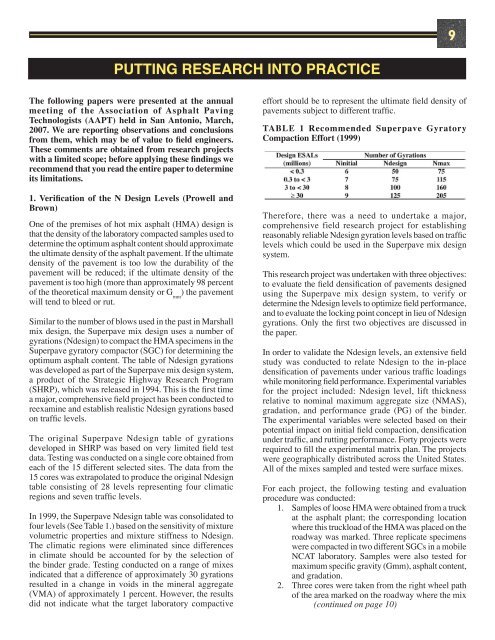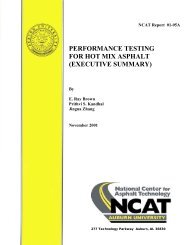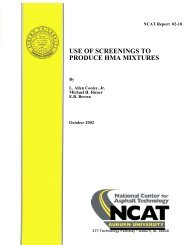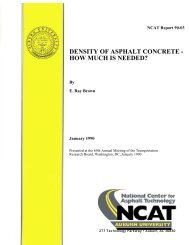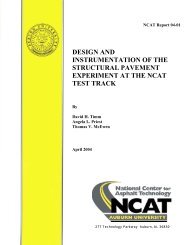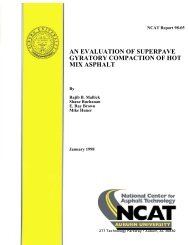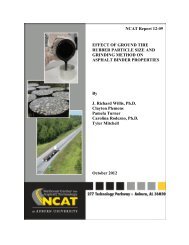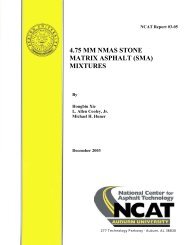ncat completes hma field compactability study - Samuel Ginn ...
ncat completes hma field compactability study - Samuel Ginn ...
ncat completes hma field compactability study - Samuel Ginn ...
- No tags were found...
You also want an ePaper? Increase the reach of your titles
YUMPU automatically turns print PDFs into web optimized ePapers that Google loves.
PUTTING RESEARCH INTO PRACTICEThe following papers were presented at the annualmeeting of the Association of Asphalt PavingTechnologists (AAPT) held in San Antonio, March,2007. We are reporting observations and conclusionsfrom them, which may be of value to <strong>field</strong> engineers.These comments are obtained from research projectswith a limited scope; before applying these findings werecommend that you read the entire paper to determineits limitations.1. Verification of the N Design Levels (Prowell andBrown)One of the premises of hot mix asphalt (HMA) design isthat the density of the laboratory compacted samples used todetermine the optimum asphalt content should approximatethe ultimate density of the asphalt pavement. If the ultimatedensity of the pavement is too low the durability of thepavement will be reduced; if the ultimate density of thepavement is too high (more than approximately 98 percentof the theoretical maximum density or G mm) the pavementwill tend to bleed or rut.Similar to the number of blows used in the past in Marshallmix design, the Superpave mix design uses a number ofgyrations (Ndesign) to compact the HMA specimens in theSuperpave gyratory compactor (SGC) for determining theoptimum asphalt content. The table of Ndesign gyrationswas developed as part of the Superpave mix design system,a product of the Strategic Highway Research Program(SHRP), which was released in 1994. This is the first timea major, comprehensive <strong>field</strong> project has been conducted toreexamine and establish realistic Ndesign gyrations basedon traffic levels.The original Superpave Ndesign table of gyrationsdeveloped in SHRP was based on very limited <strong>field</strong> testdata. Testing was conducted on a single core obtained fromeach of the 15 different selected sites. The data from the15 cores was extrapolated to produce the original Ndesigntable consisting of 28 levels representing four climaticregions and seven traffic levels.In 1999, the Superpave Ndesign table was consolidated tofour levels (See Table 1.) based on the sensitivity of mixturevolumetric properties and mixture stiffness to Ndesign.The climatic regions were eliminated since differencesin climate should be accounted for by the selection ofthe binder grade. Testing conducted on a range of mixesindicated that a difference of approximately 30 gyrationsresulted in a change in voids in the mineral aggregate(VMA) of approximately 1 percent. However, the resultsdid not indicate what the target laboratory compactiveeffort should be to represent the ultimate <strong>field</strong> density ofpavements subject to different traffic.TABLE 1 Recommended Superpave GyratoryCompaction Effort (1999)Therefore, there was a need to undertake a major,comprehensive <strong>field</strong> research project for establishingreasonably reliable Ndesign gyration levels based on trafficlevels which could be used in the Superpave mix designsystem.This research project was undertaken with three objectives:to evaluate the <strong>field</strong> densification of pavements designedusing the Superpave mix design system, to verify ordetermine the Ndesign levels to optimize <strong>field</strong> performance,and to evaluate the locking point concept in lieu of Ndesigngyrations. Only the first two objectives are discussed inthe paper.In order to validate the Ndesign levels, an extensive <strong>field</strong><strong>study</strong> was conducted to relate Ndesign to the in-placedensification of pavements under various traffic loadingswhile monitoring <strong>field</strong> performance. Experimental variablesfor the project included: Ndesign level, lift thicknessrelative to nominal maximum aggregate size (NMAS),gradation, and performance grade (PG) of the binder.The experimental variables were selected based on theirpotential impact on initial <strong>field</strong> compaction, densificationunder traffic, and rutting performance. Forty projects wererequired to fill the experimental matrix plan. The projectswere geographically distributed across the United States.All of the mixes sampled and tested were surface mixes.For each project, the following testing and evaluationprocedure was conducted:1. Samples of loose HMA were obtained from a truckat the asphalt plant; the corresponding locationwhere this truckload of the HMA was placed on theroadway was marked. Three replicate specimenswere compacted in two different SGCs in a mobileNCAT laboratory. Samples were also tested formaximum specific gravity (Gmm), asphalt content,and gradation.2. Three cores were taken from the right wheel pathof the area marked on the roadway where the mix(continued on page 10)


